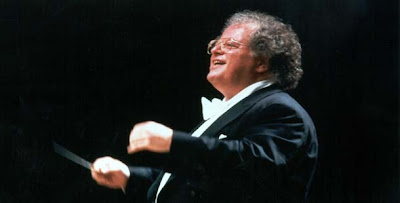Hi folks and welcome to the live blog of tonight's
Anna Bolena at the Metropolitan Opera House. I'll be doing the same thing as last season, following the live broadcast and updating throughout the evening. Hope you all enjoy
Anna Bolena which you can listen to
here.
6:11pm:
Deborah Voigt interviewing Fabio Luisi on the red carpet in the pre-game show. Asking about the Don Giovanni and welcoming him to the Met family.
6:16pm:
Margaret Juntwait and William Berger talking about the new start times: 7:30pm Eastern Time is the new early start time. Got to get the audience home to Long Island and Westchester. So get to the theater on time or you'll watch the opera in List Hall. Now onto the three Russians singing the leads in the new
Anna Bolena. Now WB is running down the season of HD broadcasts. Hope he read my preview.
6:18pm:
Deborah Voigt interviewing Tyne Daly (Maria Callas in the revival of
Master Class on Broadway).
6:23pm
DV talks to
Enchanted Island designer Julian Crouch. Frighteningly good cast and hope it's better than it sounds. Plot is
A Midsummer Night's Dream's lovers walking into the island of
The Tempest. Would be better if it were Zerbinetta and Arlecchino added to the show to get it done before the fireworks go off.
6:26pm
Pre-recorded featurette with
Anna Bolena costume designer.
6:30pm
Summing up the plot of Act I it's getting ready for game time. I've got £10 on the mezzo. Orchestra warming up.
6:35pm:
Plot analysis as they wait for the show to start.
6:40 pm:
Marco Armiliato to conduct the
Star-Spangled Banner before the opera actually starts. Oh what heights we'll hit--but they really should play
God Save the Queen.
6:44pm:
"and the hoooooome of the braaaaaave!" PLAY BALL!
ACT I: 6:46pm:
Marco Armiliato takes the podium. Anddddd.....
Dark chivvying figures in the cellos answered by woodwinds and horns. Establishing grim atmosphere of what is to come with that short bass solo, almost a recitative. Can hear how this points the way to Verdi's
Don Carlo. Second half brighter, a Rossini-like crescendo as heard in a lot of
bel canto.
Last time I heard this it was played by 13 musicians--different with a full band!
6:55pm:
Curtain is up and dark castle atmosphere established by the Met Orch.--who sound really great tonight. Ditto the chorus. Guess having a new contract helps!
6:57pm:
Mezzo Ekaterina Gubanova makes her entrance as Giovanna (Jane) Seymour, Anna's lady-in-waiting and soon to be the next Queen of England. Gubanova was an 11th-hour replacement for a pregnant Elina Garanca.
6:59pm:
Audience applauds suddenly--La Netrebko enters. They trade recitatives.
7:01pm:
Tamara Mumford as Smeton, with whom Anna may (or may not) be smitten. Nice mezzo
cavatina.
7:04pm
Great theatrical device: the Queen interrupts Smeton (Smeaton?) for her own first aria, "Come, innocente giovine," Netrebko's instrument sounding fit and flexable with a strong center tonal column. Now to the upper register and you can hear the breaths being held.
Bella.
7:08pm:
Netrebko hitting those high intervals like a skier doing a sweeping slalom. Now for the
fioratura and that first thrilling Family-Circle reaching high note--and a second, third and fourth. Damn she's floating 'em. Applause.
7:10pm:
Next scene: Giovanna and Enrico's duet. Ildar Abdrazakov sounding impressive, now that he's not wearing a plumed light-up Prada helmet. Maybe he is. I only have audio.
7:24pm:
Long, impressive duet between King Hank and Queen Jane ends with the feed punking out for 15 seconds. Curse you, Internet technology.
E maleditto!
7:28pm:
Enter the tenor: Stephen Costello as Percy who is happy not to have any of his big scenes cut. Now, "Da quel dì che, lei perduta" gives him his first chance to strut his stuff. Nicely pushed high note with a little
sforzando.
7:36pm:
Tension rising and everyone in place for that big kick-ass quintet with chorus. Netrebko launches it with some gorgeous if breathy singing. Abdrazakov solid and deep a black-toned voice.
7:48pm:
Mumford returns as Smeton for a big three-verse aria. (checks libretto) Queen will not interrupt him this time....I think.
7:51pm: Everyone behind the arras! "Dead, for a ducat! Dead!" Hmmm. Wrong opera. Plot thickening up 'til the king's entrance and the last ensemble that ends the act.
8pm: Netrebko injecting real emotion and heart-melting tone into "Per pietà del mio spovento." That's why the lady's face is all over town. Costello's pretty good too here with some rich delivery and just a hint of vibrato but not unsteady.
8:03pm: Heard a page turn. The prompter?
8:08pm: King Enrico VIII is now onstage for the final chorus from "How to Murder Your Wife." Make that the Act I finale where he accuses Anna of infidelity and has her escorted off to the Tower.
 |
Action shot from the end of Act I. Those sets are really oppressive looking.
That's Netrebko in the red dress, Costello next to prompter's box.
Re-posted from @MetOpera Twitter on Yfrog. © 2011 Metropolitan Opera. |
8:15pm: And that's the curtain on Act I to a roar of approval from the house. Get the axe.
INTERMISSION:
8:16pm: Deborah Voigt interviewing Gubenova (Jane Seymour) and Abdrezakov (Enrico VIII, the
ocho) "How do you embody the King of England?" "I have little bit of blood of Genghis Khan."
Say what?
8:33pm: Nice interview feature with Ira Siff, and now pre-recorded interview with Netrebko on the technical side of singing Anna. Character is "not a poor innocent victim. Let's not forget what she was, ambitious."
8:40pm: Apropos of nothing, Mariusz Kwiecien with a plug for
Don Giovanni.
8:44pm: "And I love
Manon." "And I love
Manon." Orchestra is warming up....
ACT II:
8:54pm: Conductor to the pit and off we go with Act II.
8:58pm: Long expository chorus of the Queen's retainers and ladies--this
is kinda like
Don Carlo.
9:01pm: Nice horn playing from the Met pit. Enter Gubenova. Here's the big duet: "
Dio che mi vedi in core". Queen Anna vs. Queen Giovanna for all the (metaphorical) operatic nachos.
9:09pm: This duet is kicking so much butt right now I'm not sure what to be live-blogging about it. Um it's awesome and these ladies are burning up the stage? Yeah. That'll do.
9:16pm: And the crowd goes wild.
9:17pm: Back to the opera.
9:25pm: Fire-breathing confrontation between Enrico, Percy and Anna. Netrebko is exceptional here getting better as the opera goes on. Stephen Costello very strong here and Ildar getting a lot out of playing the King as a complete tool.
9:35pm: Trio ends with Netrebko tossing up some pretty awe-inspiring high notes matched by Costello.
9:38pm: Giovanna and Enrico where she learns she's being promoted and is probably not too happy about it. Abdrazakov rich and resonant in this rep, a dark, resonant quality that is not the prettiest sound but satisfying for this role--voice like a Guinness Stout.
9:41pm: Gubenova laying claim to this role and tossing off some inpressive
legato singing pushing herself up for all that she's worth, fading soft, going deep and then heading back to the heights in this impressive duet. I don't think this third marriage will work out.
9:46pm: One of those tough Donizetti cabalettas that is like a rapidly rising staircase as she pleads with the King to be merciful to Anna. Really impressive singing here.
9:48pm: The Tower Scene and Stephen Costello's big aria. Hard to believe this important sequence was almost cut from the run of the show. Here we go: "Vivi tu." Go get 'em.
9:52pm: Impressive, if a little restrained. Here's the b section with some skyscraper notes. Up. Up, and...he took the Par 5. Still pretty good singing but not brain-melting. Still, good job.
9:55pm: La Netrebko back on stage for the tripartite Mad Scene. But first a chorus that goes on for five minutes.
10:01pm: Here we go. Some parallels with
Lucia esp. the flute solo.
10:05pm: Feed punked for a second. She's out of the slow section and moving up on the steep rise and drop of the first climax. Sounded like she collapsed to the stage. Gorgeous, sultry tone laced with pain and heartbreak.
10:07pm: Conductor leading her very slowly and she's starting to produce these trills and tremolos. Not a wobble (she's doing this on purpose) and the effect is thrilling, almost hypnotic. Delicate, pointillist singing from an artist in total control of her instrument and at the top of her game.
10:10pm: Top deck for the
a capella trope. Down the stairs, THERE's the big high note up at the top and and out of the aria. BRAVA!
10:11pm: The house being brought down. That was pretty + awesome = pretty awesome.
10:12pm: OK. Last scene.
10:22pm: My Internet ganked. Just went down completely. Got to catch the last bits of the final scene but not really the very last aria. Caught the last minute with some impressive, fiery singing from La Netrebko but not enough musical information to really make a judgment on her performance in the last part of that aria. Sigh.
Well, that's the peril of live-casting an opera folks. You can have two computers, everything set up to go and then Time Warner croaks on you and decides you don't get to hear the very last 10 minutes of the opera. Hope you've enjoyed the performance, of both this writer and of the live broadcast, which was really great until I couldn't hear it anymore.
Stay tuned to this blog for a review of tomorrow night's
Nabucco where I'll actually be in the theater and not at the behest of the Internet. This was a great way to start the season and I hope you had as much fun reading it as I had doing it--until the last ten minutes, anyway.



























